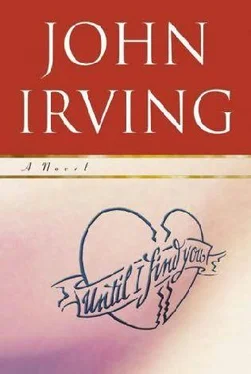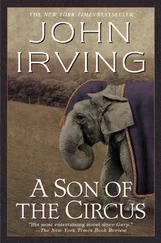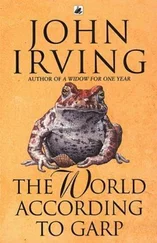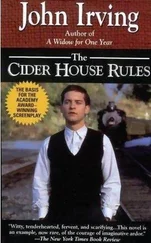He apologized for wasting Madame Lebrun’s and Mr. McSwiney’s time by agreeing to a meeting in Halifax, which he now believed was pointless. Jack added that his one look at the so-called explosion window in St. Paul’s Church drove home to him how McSwiney had managed to write a disaster movie both prurient and banal; he’d made a sordid love story out of the Halifax Explosion.
Jack forgot to tell Cornelia Lebrun that he remained interested in working with her as a director, which of course had initially persuaded him that the meeting in Halifax was a good idea. He also forgot to tell her that he’d been involved in enough cross-dressing to satisfy whatever slight yearning he might have felt for transvestite roles; as an actor, Jack didn’t feel it was asking too much to be allowed to be a man.
Notwithstanding these omissions, he left a great mess of pages at the front desk of the hotel—a virtual ream of Prince George stationery, to be delivered to Madame Lebrun’s room. Then Jack went off to the Press Gang restaurant for a solitary dinner. When Jack returned to the hotel, he inquired at the front desk if Cornelia Lebrun had left a message for him; he was told she was in the bar.
Jack had only a dim idea of what the French director looked like. (A small woman in her sixties—about the same age as Miss Wurtz, he thought.) He spotted her easily. How many women in Halifax were likely to wear a suede pantsuit in lily-pad green?
“Cornelia?” Jack said to the little Frenchwoman, whose lipstick was a bold orange.
“Zzzhhhack Burns!” she cried, but before he could kiss her offered cheek, a large, hirsute man forced his way between them.
The man was bigger than any of his book-jacket photographs, and more hairy than a lumberjack. Jack had been unable to read the fur-faced author’s novels due to the persistence of the rugged outdoors on every page—a characteristic relentlessness in the prose. (Fir trees bent by the wind, the gray rock of the Canadian Shield, the pitiless sea—harsh weather and hard drinking.) Even the whisky on the author’s breath was bracing—Doug McSwiney, of course. Jack was reaching to shake his hand when McSwiney’s left hook caught him on the right temple. Jack never saw it coming.
“ Suck on that!” McSwiney said, but Jack heard only the suck; he was out on his feet before he fell. He should have had the brains to expect a cheap shot from a writer insensitive enough to turn the Halifax Explosion into an unwholesome love story.
Jack came to in his hotel room. He was lying on his back on his bed with his clothes on but his shoes off; his head was pounding. Cornelia Lebrun was sitting on the bed beside him. She had wrapped a wet washcloth around some ice cubes, which she held against the swollen bruise on Jack’s right temple. The drunken, bearded bastard could have killed me, Jack was thinking.
“Eet’s my fauld,” Madame Lebrun was saying. “I can’t read English when eet’s in writing-by-hand. ”
“ Longhand, ” Jack corrected her.
“I asked Dougie to read your notes out lout to me. Beeeg faux pas, oui ? I theenk the word sucked was what deed eet to heem.”
“Or banal— or prurient, maybe.”
“ Oui. Alzo hee’s dreenking.”
“I’ve had bad reviews myself,” Jack told her. “I didn’t try to club Roger Ebert to death with my Oscar.”
“Clup who to dead?” the little Frenchwoman asked.
“It doesn’t matter. I don’t want to be in the movie,” he told her.
“I would cast a Frenchman to play Le Medec, Zzzhhhack—no matter how goot your axzent ees.”
She would never get the movie made, anyway. Later that year, after the terrorist attacks on September 11, it would be too difficult to find financing for a film about the Halifax Explosion—even with a movie star in it. Suddenly, disaster movies weren’t all that appealing. (This feeling would persist for a whole year or more.)
Something about the Halifax Explosion appeared on Canadian television, but that happened a couple of years later and Jack never saw it. He didn’t even know if it was a documentary or what Miss Wurtz would have called a dramatization. Jack only knew that Doug McSwiney had had nothing to do with it. And after that introduction in the bar of The Prince George, Jack doubted that he would ever work with Cornelia Lebrun.
The hotel sent a female doctor to Jack’s room while Madame Lebrun was still attending to his head injury. The doctor told Jack that he had a mild concussion; from the beat of his pulse in his right temple, he might have disputed the word mild with her. She also told him that he shouldn’t sleep for more than two hours at a time. The doctor left instructions at the front desk to give Jack Burns a wake-up call every two hours; if he didn’t answer his phone, someone had to go into his room and wake him up. And he shouldn’t travel for another day, the doctor said.
That night, between the wake-up calls, he had dreams of being on a movie set. “Hold the talking, please,” someone on the set would say, for what seemed like the hundredth time.
“Picture’s up.”
“Stand by.”
It made Jack realize that he missed the process. Maybe it had been too long since he’d made a movie.
In the morning, Jack walked along Barrington Street, looking for something to read. He found a bookstore called The Book Room. The owner recognized him and invited him to have a coffee with him. Jack volunteered to sign some books—just what they had on hand of the screenplay of The Slush-Pile Reader. (Emma’s paperback publisher had published the script; in most bookstores, the screenplay was on the shelf alongside the movie tie-in edition of Emma’s novel.)
The bookseller’s name was Charles Burchell; he turned out to be the grandson of C. J. Burchell, the legendary maritime lawyer who’d led the court-room attack on the Mont Blanc ’s captain and pilot. When Jack told Charles that he thought he’d been born in the St. Paul’s Parish House, Charles told Jack that the vestry of the church had been used as an emergency hospital in the days following the Halifax Explosion; the bodies of hundreds of victims had been laid in tiers around the walls.
Charles was kind enough to take Jack on a tour of the harbor. Jack wanted to see the ocean terminals, particularly the pier where the immigrants landed. Charles also drove Jack to the Fairview Lawn Cemetery. Jack was curious to see the Titanic grave site. Halifax had seen its share of disasters.
Jack walked with Charles among the gravestones.
ERECTED TO THE MEMORY
OF AN
UNKNOWN CHILD
WHOSE REMAINS
WERE RECOVERED
AFTER THE
DISASTER TO
THE “TITANIC”
APRIL 15, 1912
There were many more.
ALMA PAULSON
AGED 29 YEARS
LOST WITH FOUR CHILDREN
Some were just names with their ages.
TOBURG DANDRIA AGED 8
PAUL FOLKE AGED 6
STINA VIOLA AGED 4
GOSTA LEONARD AGED 2
Others were just numbers.
DIED
APRIL 15, 1912
227
A small headstone marked J. DAWSON had the largest number of flowers—bouquets of flowers dwarfed the headstone, almost obscuring the oddly familiar name. Charles told Jack why the name was familiar. The character Leonardo DiCaprio played in the Titanic movie was named Jack Dawson.
“You don’t mean he was real, ” Jack said.
“I have no idea,” Charles said.
The J. DAWSON on the headstone could have been a different Dawson. Jack Dawson, DiCaprio’s character, might have been invented. But since the movie had been released, visitors to the Titanic grave site put flowers on J. DAWSON’s headstone because they believed he was that character. Worse—whether or not Jack Dawson in the movie was related to J. DAWSON on the headstone, the young girls bringing flowers thought there was someone in that grave who had once looked like Leonardo DiCaprio.
Читать дальше












